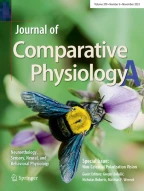Abstract
In many neuronal systems, information appears to be represented in the activity of populations of neurons. Such neuronal population codes must also be read out, or interpreted, by downstream networks. Recent studies in both vertebrate and invertebrate systems have begun to elucidate some of the general mechanisms underlying these processes. Directed behaviors, that involve a directional response to a directional sensory input, have been a particularly useful context for these studies because, among other things, their input-output relationship is easily defined and experimentally controlled. We have recently shown that the neuronal network underlying a directed behavior in the medicinal leech utilizes a specific population coding scheme based on a neuronal population vector. A population vector of mechanosensory neuron activity correlates well with behavioral output and the connectivity of the downstream network is well suited for accurately reading out this population code.
Similar content being viewed by others
Author information
Authors and Affiliations
Additional information
Accepted: 17 April 1999
Rights and permissions
About this article
Cite this article
Lewis, J. Sensory processing and the network mechanisms for reading neuronal population codes. J Comp Physiol A 185, 373–378 (1999). https://doi.org/10.1007/s003590050397
Issue Date:
DOI: https://doi.org/10.1007/s003590050397
